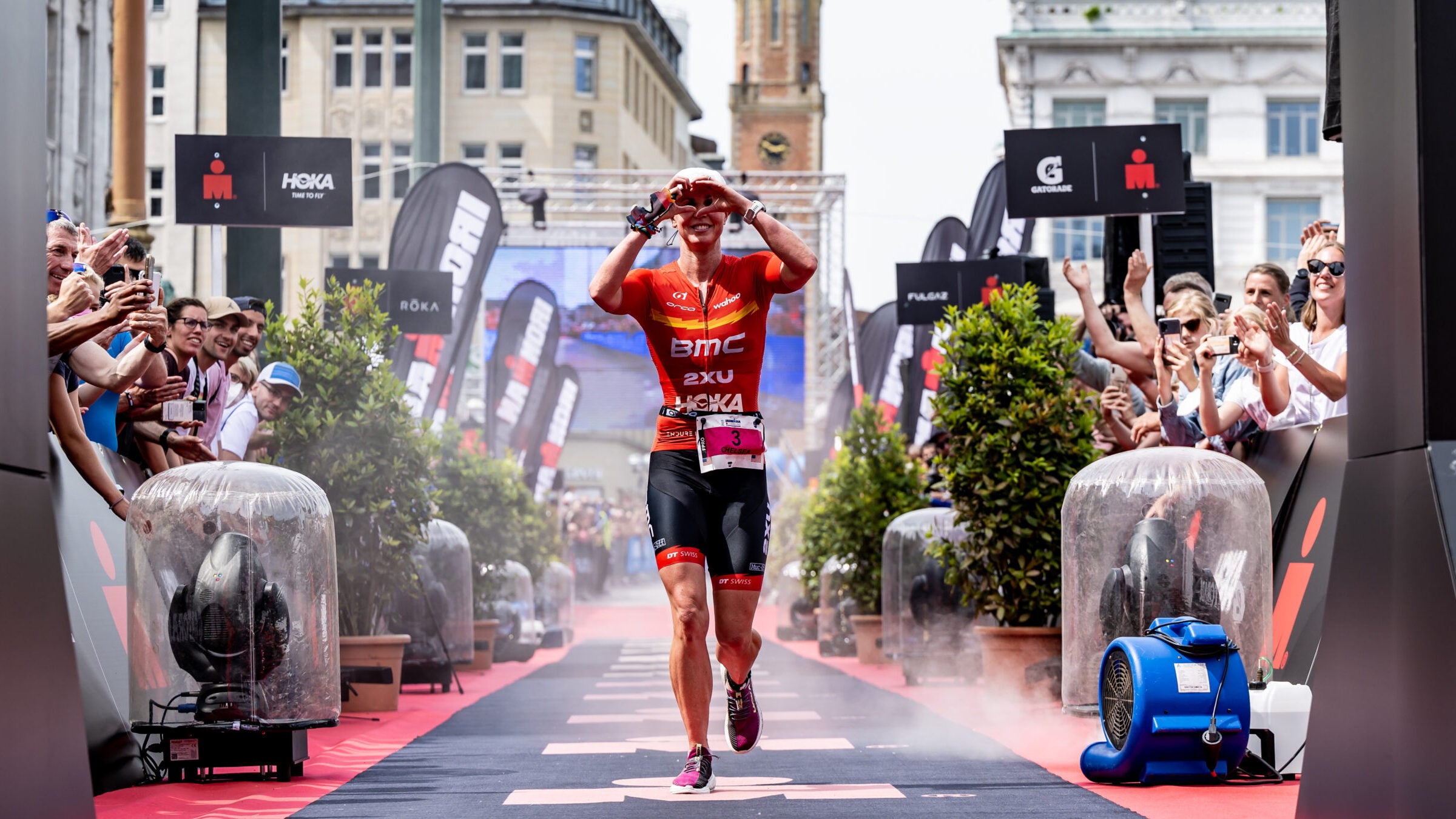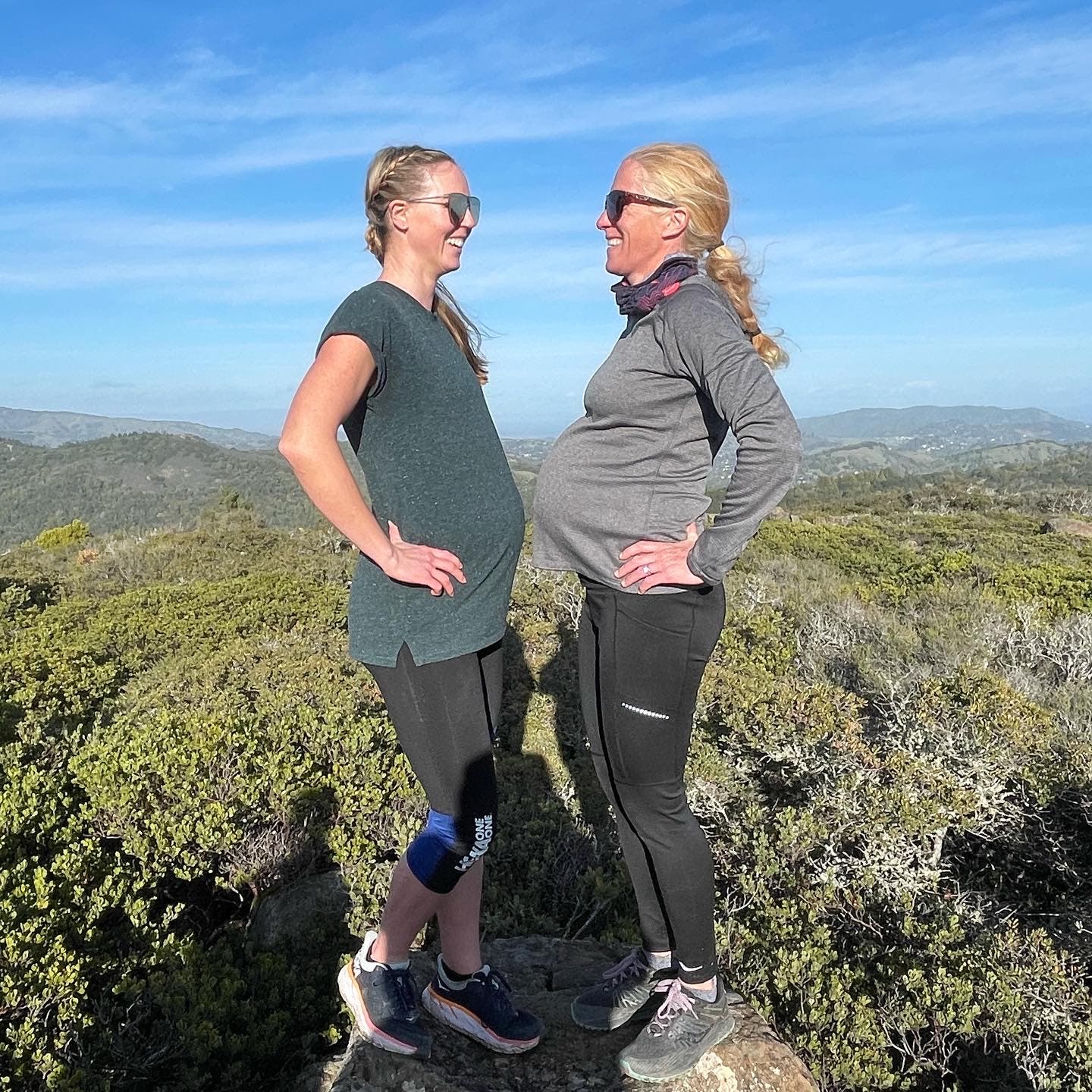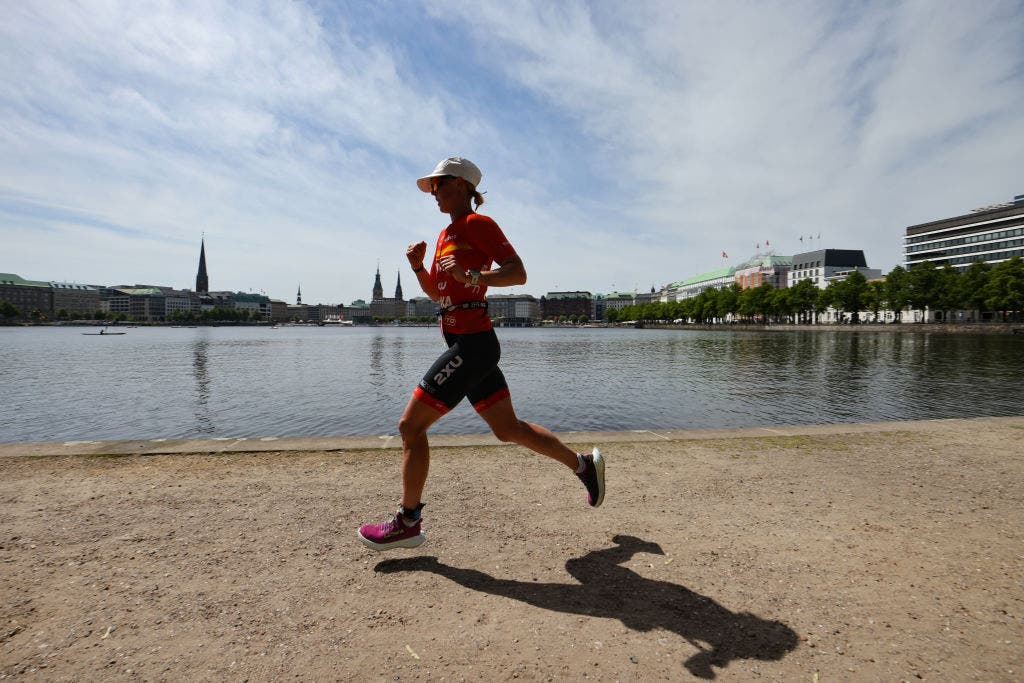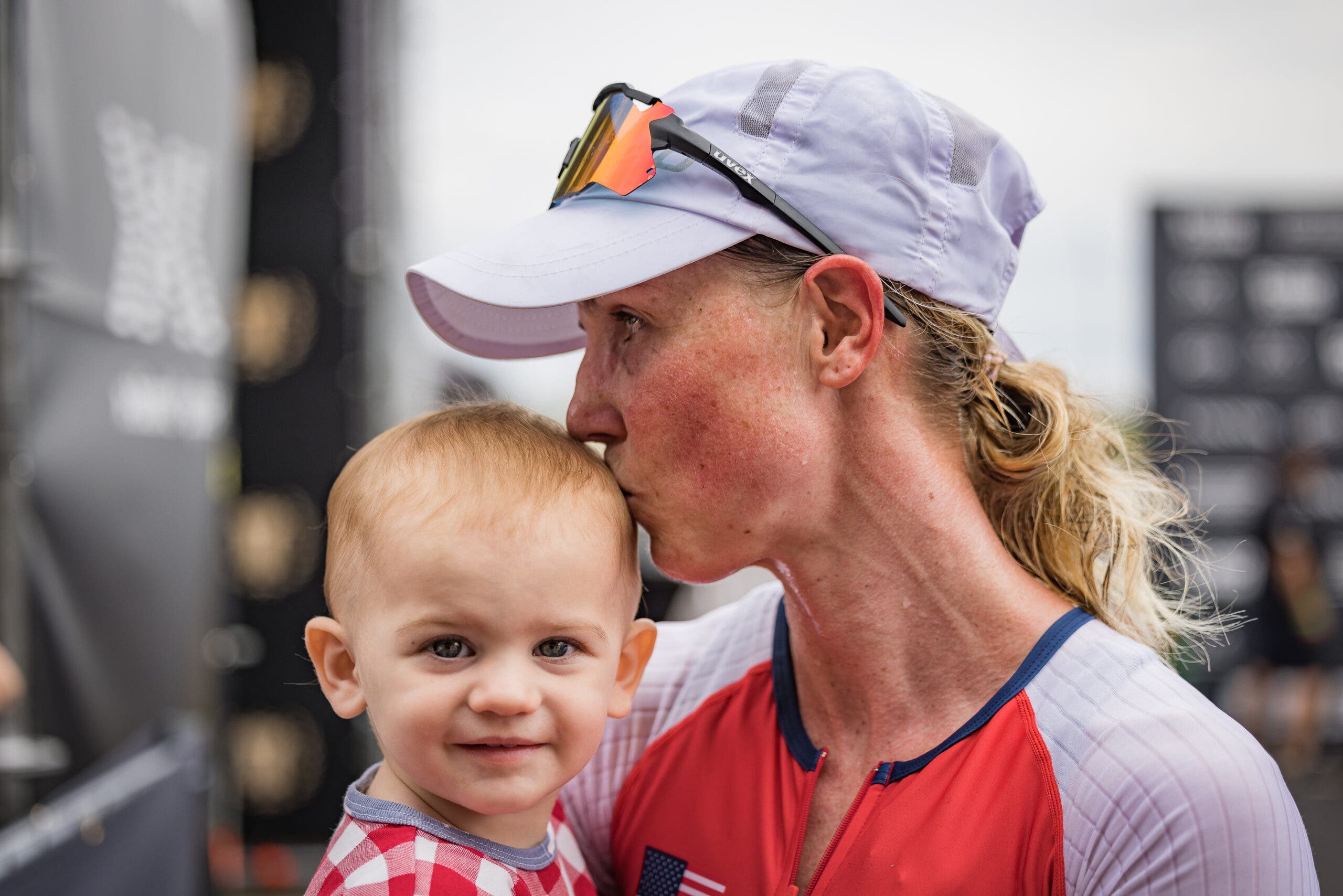With Kona in Sight, Chelsea Sodaro is Rediscovering Her Fire

(Photo: Alexander Scheuber/Getty Images)
Some athletes, afraid to fail, can be modest about their goals. They fly under the radar, waiting patiently for their moment, not wanting to call the shot in case it lands wide. But Chelsea Sodaro’s biggest accomplishments have always come from making the bold move — and from seizing the moment, no matter the timing.
So, as Sodaro sets her sights on Kona this October, a year-and-a-half postpartum with just one prior Ironman finish on her otherwise 70.3-heavy resume, you’d be wise not to count her out.
RELATED: The 2022 Kona Ironman World Championship Pro Qualifiers
Not afraid to fail
Sodaro was a standout collegiate runner at UC Berkeley with three All-American credits to her name. After graduation, she turned pro, earning multiple national titles on the road and in indoor track. She set her sights on the 2016 Olympic Games, but on-and-off injuries led to a disappointing finish in the 10K at the Olympic Trials. Nearing burnout and cross-training through her injuries, she became intrigued by Gwen Jorgensen and the depth of the U.S. Women’s Olympic Triathlon Team. Watching Jorgensen’s 2016 gold-medal performance on TV with her husband, Steve Sodaro, an idea was born.
Steve was convinced his wife could excel in triathlon, given that two of the three U.S. women in Rio were collegiate runners-turned-triathletes. Skeptical, Sodaro decided it was at least worth a shot. She bought a road bike and started training with Steve, a sub-four-minute miler whom she’d met on the track team at Berkeley. Just a few months later, Sodaro took the plunge, moving to California to train with an elite triathlon squad and pursue the sport full-time.
“I’m a pretty emotional athlete. I’m not afraid to fail — and I have failed so, so much. That being said, I don’t think it was initially a really well thought out decision,” Sodaro said. “But I loved the challenge, and I initially loved being in that environment. After being a runner my whole life, it was fun to see so much progress so quickly.”
Sodaro earned her elite license in her first attempt at the Clermont Draft-Legal Challenge, and in two seasons on the World Triathlon circuit, she garnered two World Cup and three Continental Cup podiums.
But the lifestyle of short-course racing, where spending months abroad and living out of a suitcase is the norm, didn’t appeal to Sodaro. She preferred being closer to home and putting in longer training blocks. So, she set her sights on long-course racing. In 2018, she earned a podium in her first 70.3 in Waco, Texas, followed by a win at 70.3 Indian Wells. Later that season, she placed fourth at the Ironman 70.3 World Championship in Nice, France, and signed with the BMC Pro Triathlon Team.
“I feel like I’ve worked so hard for so long in running and in triathlon, and I was always kind of on the cusp of making it and being able to make a real living,” Sodaro said. “Now, I’m 33 and I’m supporting my family doing this, which is kind of mind-blowing.”
Starting a family mid-career

When COVID halted racing around the globe in 2020, Sodaro and her husband saw an opportunity to start a family. Even before Skylar Sodaro was born on March 16, 2021, Sodaro’s identity was changing. She became an advocate for maternity leave in elite sport, praising the Professional Triathletes Organisation for its newly announced maternity policy and to her sponsors for continuing their support throughout her pregnancy.
Sodaro was determined to stay fit through pregnancy and to return to racing on the elite stage. On the search for a new coach, she connected with New Zealand-based Dr. Dan Plews—who has also been working with Olympic silver medalist Javier Gomez on his move to long course. In the same phone call that she asked him to work with her, she also shared that she was six weeks pregnant.
“I told him I would totally understand if he didn’t want to take me on, because that was not part of, you know, the initial plan,” Sodaro said. “And the first thing he said was, ‘That is so exciting. That’s the best news, I’m so happy for you. And yes, I would still like to coach you, and how can I support you?’ I think that’s really unique for a male coach to respond that way, especially one who is so accomplished and so good at what he does. I just feel really lucky that he believed in me.”
Sodaro, in consultation with Plews, soon declared her next ambitious goal — to qualify for and compete in the Collins Cup at five months postpartum.
On comebacks and setbacks

Returning to top form was difficult. Sodaro experienced morning sickness for her entire pregnancy. After Skye was born, the combination a difficult feeding journey, postpartum anxiety, and the everyday struggles of new parenthood made her Collins Cup goal feel distant. When Plews sent her a text about restarting a structured training plan six weeks after birth, she didn’t feel ready, but she decided to trust the process.
“I think most first-time parents think they’ve got an idea, but really, they have no idea,” Plews, a father of two, said. “The reality of how hard it actually was, I don’t think she really realized. But she kept on going with that goal, and she ended up doing exactly what she wanted to do.”
While she successfully toed the line at the 2021 Collins Cup, she also suffered a stress fracture later that season — just before 70.3 Worlds. The strain she was putting on her body through a combination of heavy training, lack of sleep, and breastfeeding had finally come to a head. She took the rest of the season off. She, Steve, and Skye moved to Reno, Nevada, so Steve could start a new career as a firefighter. They settled into a new rhythm as a young family.
It took more than a year for Sodaro to find her flow in racing again — especially on the run, the discipline that had always been her strength.“I always had a lot of confidence in that skill and my ability to hunt people down,” Sodaro said. “That was very challenging coming back from having my daughter. I just did not feel like myself running, which has been frustrating when so much of my identity has been as a runner. I had so many failed running workouts, and I never really knew what version of myself was going to show up… It’s really only in the last month that I kind of feel that magic coming back, where my stride feels powerful.”
Sodaro credits her support team, including Plews as well as Dr. Sara Tanza, her Aptos, California-based pelvic floor specialist; Dr. AJ Gregg, her Flagstaff, Arizona-based strength coach; and Dr. Kris Blum, her Reno-based chiropractor for guiding her postpartum return to fitness.
RELATED: Guidelines for Returning to Triathlon Training Post-Pregnancy
In top form
The early months of 2022 were spent increasing volume and preparing for a long-awaited step up in distance. In June, she made a bold statement at the Ironman European Championship in Hamburg — placing second to German Laura Philipp and recording the second-fastest women’s Ironman debut in history in 8 hours, 36 minutes.
She followed that with a third-place finish at the PTO Canadian Open in July — a race where, after a career-worst swim, she chased down her competitors on the bike and run to secure a Collins Cup qualification. In the final kilometers of the run, she felt that familiar confidence returning as she surged to a podium spot.As witness to his wife’s running journey since the collegiate days at Berkeley, Steve Sodaro has noticed her swagger coming back in recent races.
“Running was her secret weapon,” Steve Sodaro said. “She would just mow people down. If you were within five minutes of her on the run, you were getting caught. So, she kind of lost that sheet of armor up until Hamburg and the PTO race in Canada, where she finally said she felt like herself again — and you could just tell.”
Now, with her IM World Championship debut just weeks away, Sodaro can’t wait to mix it up with the world’s best.
“I do think she’s quite built for Kona. She’s very good in the heat, she’s very economical and she’s very efficient,” Plews said. “To do well your first time in Kona is very, very hard, so all we can do is prepare as best we can and then execute a good race on race day. She’s definitely capable of putting in a very good performance, and long-term, to get on the podium and maybe even one day get a title. Who knows?”
But even as Sodaro rediscovers the competitive fire she had pre-Skye, she is a different person now. She manages a hectic schedule, balancing training and parenthood alongside Steve’s demanding job. As the mom of a toddler, she knows to expect the unexpected and to never cling too hard to the plan. When childcare falls through, she remembers Plews’ advice to “let the most important thing be the most important thing,” and that one missed workout doesn’t wreck the whole training cycle.

Now Sodaro’s goal is to race with pride, to show other female athletes that you don’t have to choose between motherhood and elite competition. She races to show Skye she can be anything she wants to be, in hopes her daughter will one day chase her own passions without hesitation.
And more than anything, she knows that win, loss, or DNF — good workout or bad — Skye’s sweet smile awaits her at the end of each day, and her husband’s love and support are unconditional.
“I want Skye to feel like she’s the center of my universe, regardless of whether I’m doing this or not,” Sodaro said. “I want her to see what it looks like to pour yourself into your dreams, and that being passionate about your career and being a good mom are not mutually exclusive. And that you can do all these things, but you don’t have to do them by yourself.”